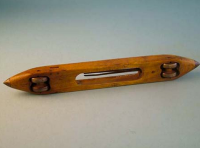The flying shuttle was one of the key developments in the industrialization of weaving. It allowed a single weaver to weave much wider fabrics, and it could be mechanized, allowing for automatic machine looms. It was patented by John Kay (1704–c. 1779) in 1733.
John Kay (17 June 1704 – c. 1779) was the inventor of the flying shuttle, which was a key contribution to the Industrial Revolution. He is often confused with his namesake,who built the first ""spinning frame"".
In 1733,he received a patent for his most revolutionary device: a ""wheeled shuttle"" for the hand loom.It greatly accelerated weaving,by allowing the shuttle carrying the weft to be passed through the warp threads faster and over a greater width of cloth.It was designed for the broad loom, for which it saved labour over the traditional process, needing only one operator per loom (before Kay's improvements a second worker was needed to catch the shuttle).
Kay always called this invention a ""wheeled shuttle"", but others used the name ""fly-shuttle"" (and later, ""flying shuttle"") because of its continuous speed, especially when a young worker was using it in a narrow loom:
a speed which cannot be imagined, so great that the shuttle can only be seen like a tiny cloud which disappears the same instant.
In July 1733, Kay formed a partnership in Colchester, Essex to begin fly-shuttle manufacturing.No industrial unrest was anticipated, this being the first device of the modern era to significantly enhance productivity.But by September 1733 the Colchester weavers, were so concerned for their livelihoods that they petitioned the King to stop Kay's inventions.
The flying shuttle was to create a particular imbalance by doubling weaving productivity without changing the rate at which thread could be spun,disrupting spinners, and weavers alike.
Kay tried to promote the fly-shuttle in Bury, but could not convince the woollen manufacturers that it was sufficiently robust; he spent the next two years improving the technnology, until it had several advantages over the device specified in the 1733 patent. (Which was to be one of his difficulties in the coming patent disputes.)
In 1738 Kay went to Leeds, where his problem had become royalty collection.(The annual license fee was 15 Shillings per shuttle.)He continued to invent, patenting some machines in the same year, though these were not taken up industrially.








